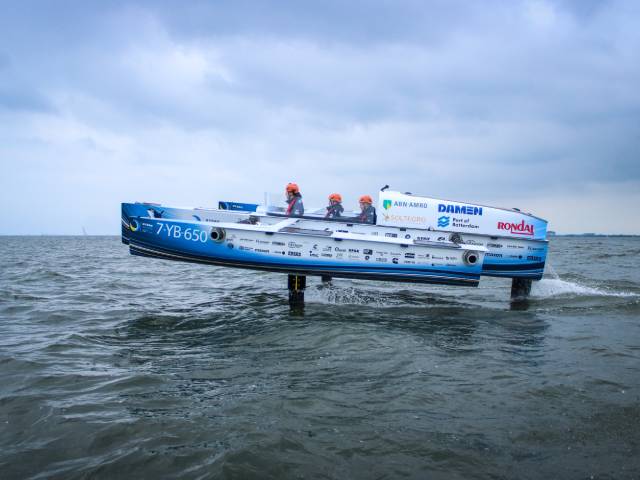This year’s Monaco Energy Boat Challenge gave spectators an appealing glimpse of the world’s first hydrogen-powered flying boat. The Hydro Motion craft, which employs a hydrogen fuel system and hydrofoils, was developed by 20 students of the Solar Boat Team of the Delft University of Technology (TU Delft) in the Netherlands. While the hydrogen is intended to keep the boat ticking at speeds of up to 40km/hr (21.6knots), the hydrofoils provide the lift to help the boat fly over the water, reducing overall energy consumption.
The Hydro Motion boat is an 8.3m x 6m trimaran, weighing 1,157kg with a full complement of three crew. Laura Hurenkamp, exposure manager for the 2021 Solar Boat Team, tells Ship & Boat International: “The three hulls of the boat and the two L-shaped hydrofoils at the front are made of carbon fibre, enabling strength while keeping the boat lightweight, and the T-shaped hydrofoil at the back is made of aluminium.” Originally, the hulls were produced in 2019 for a solar-powered boat, which would have used its deck space to store solar panels to feed the battery pack.
The boat’s power arrangement includes a 33kW hydrogen fuel cell and a 7.6kWh battery pack. “We use the batteries to provide power for starting up the fuel cell, and to provide additional power during peak consumption moments, such as take-off,” Hurenkamp continues. The fuel cell combines hydrogen with oxygen from the air to generate electricity, which powers the boat’s 60kW brushless electric motor. The motor turns an aluminium propeller, located on the back strut.
The trimaran’s hydrogen tank, supplied by Hexagon, can store approximately 8kg of hydrogen gas at a pressure of 350bar. It measures 2.3m in length, has a diameter of 500mm and weighs approximately 120kg.
The Hydro Motion achieves take-off when it hits 22km/hr, or just under 12knots. At this speed, the hydrofoils elevate the boat’s body approximately 400mm above the surface, massively decreasing resistance and thereby consuming less energy than would be the case on the water.
After a round of tests in the Netherlands, the team made its way to Monaco with the Hydro Motion, to compete against both fellow students and fully fledged tech companies in the Energy Boat Challenge. Hosted annually since 2014, this fixture was established to showcase innovative applications of clean energy to boat propulsion, combining talks and presentations with all the thrills and spills of on-the-water activities. This year’s schedule included a manoeuvrability test; a 16nm open sea sprint; and, of most interest to the TU Delft team, a long-distance trial, necessitating competitors to sail for six hours before requiring refuelling. It was in this latter event that the Hydro Motion was expected to shine.
Unfortunately, the team’s plans were scuppered by an unexpected accident on day two. The event had begun well, as Hurenkamp recalls: “We managed to sail and fly on the open sea of Monaco during the sea trials on the first day…an incredible moment for our team. We completed the manoeuvrability challenge, successfully.” However, during the sprint on the second day, the Hydro Motion hit the water hard during a landing – hard enough to damage the ‘wizard box’ that regulates the voltage.
“Unfortunately, our electronics were too damaged to repair them in time for the six-hour endurance race,” she says. Luckily, the pilots were evacuated without injury, though the boat was out of the running – for this year. However, as disappointed as the team may have been to miss the long-distance event, it’s hard to be down considering what the project has achieved.
(For the full article, please see Ship & Boat International September/October 2021)






